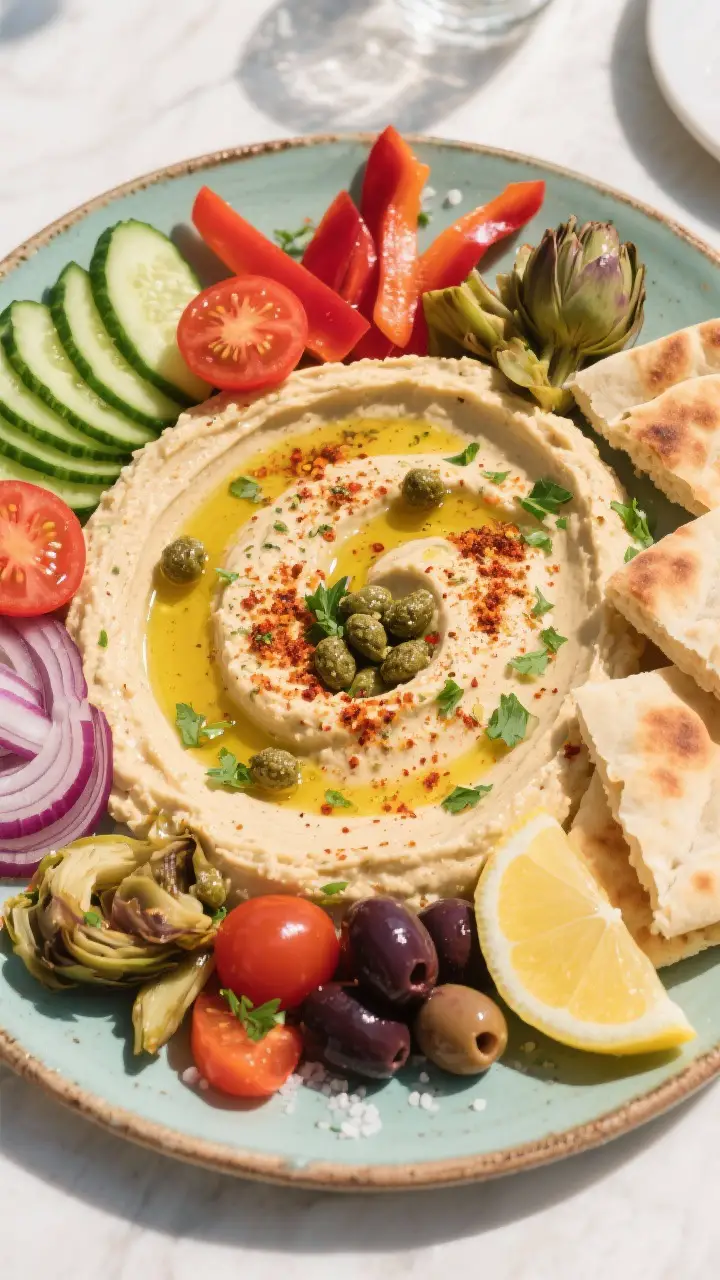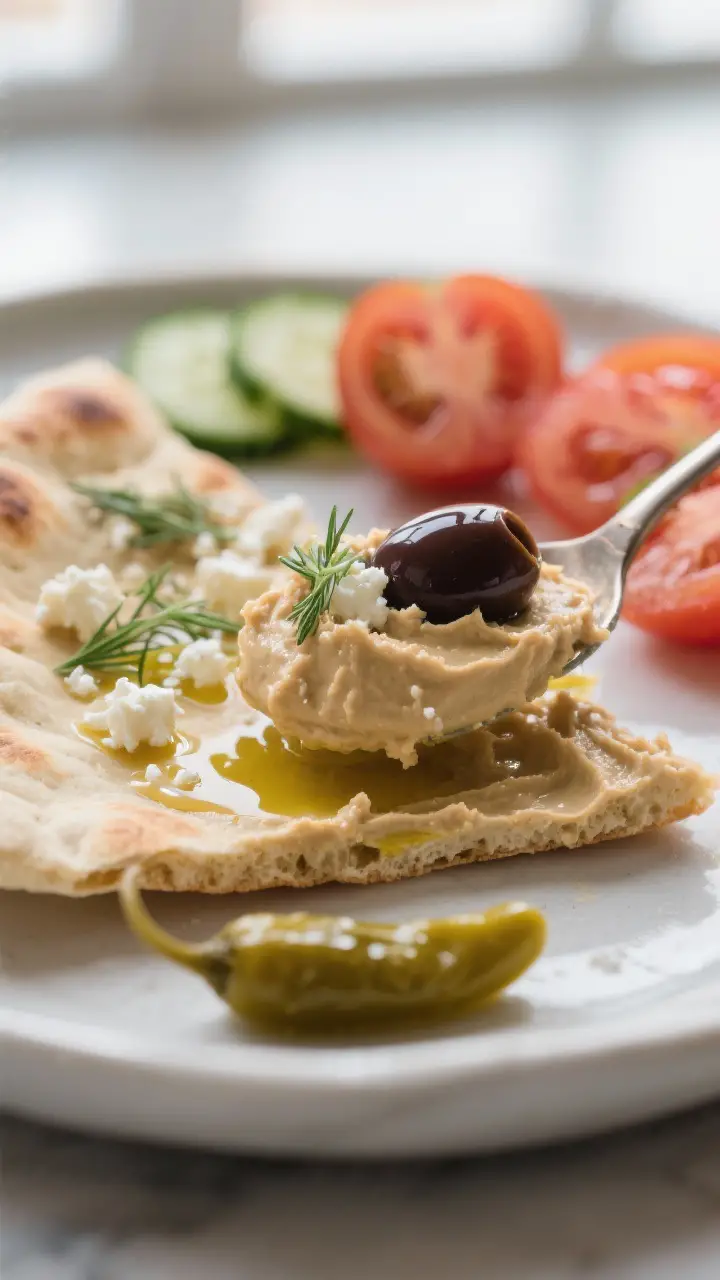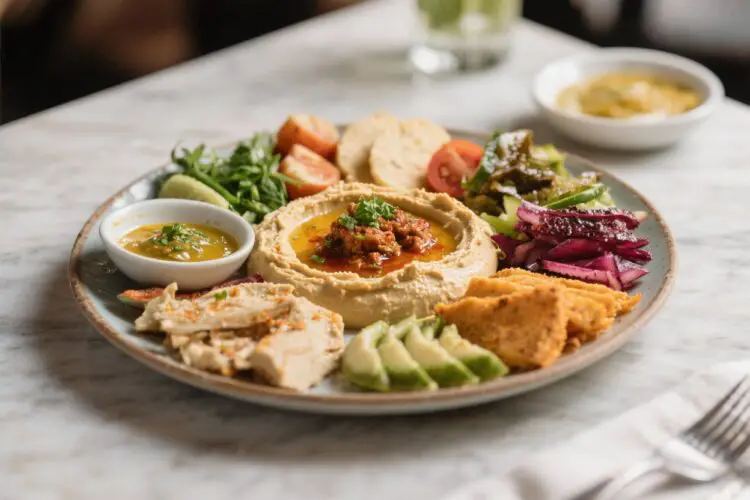A Mediterranean hummus platter is one of those dishes that looks impressive but is incredibly simple to put together. It’s colorful, fresh, and perfect for sharing with friends or family. You get creamy hummus, crisp vegetables, salty olives, and a few bright extras that make each bite different.
It works for casual snacking, a light lunch, or even a laid-back dinner. Best of all, you can prep most of it ahead and assemble in minutes.
What Makes This Recipe So Good

- Balanced flavors and textures: Creamy hummus meets crunchy veggies, briny olives, and tangy pickles. Every bite feels complete.
- Super customizable: Mix and match toppings based on what you like or what’s in your fridge.
It’s flexible and forgiving.
- Great for entertaining: It’s naturally shareable, easy to scale up, and looks gorgeous on a big platter.
- Quick and easy: Use store-bought hummus or blend your own in minutes. The rest is just slicing and arranging.
- Wholesome and satisfying: Packed with fiber, healthy fats, and plant protein. It fills you up without feeling heavy.
Ingredients
- For the hummus (homemade or store-bought):
- 1 can (15 oz) chickpeas, drained and rinsed (save a spoonful of liquid)
- 3 tablespoons tahini
- 2–3 tablespoons lemon juice, to taste
- 1 small garlic clove, minced
- 2–3 tablespoons extra-virgin olive oil
- 2–4 tablespoons cold water or reserved chickpea liquid
- 1/2 teaspoon ground cumin
- Salt, to taste
- For the platter:
- 1 cup cherry tomatoes, halved
- 1 cup cucumber, sliced into rounds or spears
- 1/2 small red onion, thinly sliced
- 1 red bell pepper, sliced
- 1/2 cup Kalamata olives, pitted
- 1/2 cup marinated artichoke hearts, drained
- 1/4 cup pepperoncini or pickled peppers (optional)
- 1/2 cup crumbled feta or dairy-free alternative
- 2–3 tablespoons capers (optional)
- Fresh herbs: parsley, dill, or mint
- Za’atar or smoked paprika, for garnish
- Warm pita, pita chips, or crusty bread
- Extra-virgin olive oil and lemon wedges, for finishing
How to Make It

- Make the hummus. In a food processor, blend chickpeas, tahini, lemon juice, garlic, cumin, and a pinch of salt.
With the machine running, stream in olive oil and enough cold water to make it smooth and creamy. Taste and adjust lemon and salt.
- Prep the vegetables. Slice the cucumbers, bell pepper, and onion. Halve the tomatoes.
Rinse and drain olives, artichokes, and capers.
- Warm the bread. Lightly toast pita or warm it in a skillet until soft and pliable. Cut into wedges.
- Assemble the platter base. Choose a large, shallow platter or board. Spread the hummus in a wide swoosh, leaving room for the vegetables around it.
- Add the toppings. Drizzle the hummus with a little olive oil.
Sprinkle with za’atar or smoked paprika. Add a handful of chopped herbs and a few capers if using.
- Arrange the vegetables and extras. Fan out cucumbers, tomatoes, peppers, onions, olives, and artichokes around the hummus. Scatter feta on top or place it in a small pile.
- Finish and serve. Add lemon wedges on the side.
Give everything a final drizzle of olive oil and a pinch of salt over the fresh veggies. Serve with warm pita or chips.
How to Store
- Hummus: Store in an airtight container in the fridge for up to 5 days. Drizzle a thin layer of olive oil on top to keep it from drying out.
- Veggies: Keep sliced vegetables in separate containers with paper towels to absorb moisture.
They’ll stay crisp for 2–4 days.
- Assembled platter: Best enjoyed fresh. If you have leftovers, store components separately so they don’t get soggy.
- Freezing: Hummus freezes well for up to 3 months. Thaw overnight in the fridge and reblend with a splash of water or lemon.

Why This is Good for You
- Plant protein and fiber: Chickpeas help keep you full and support steady energy.
- Healthy fats: Olive oil and tahini provide heart-friendly fats that make meals more satisfying.
- Vitamins and antioxidants: Fresh vegetables add vitamin C, potassium, and beneficial plant compounds.
- Lower-glycemic balance: Pairing carbs with protein, fiber, and fats helps stabilize blood sugar.
- Mindful eating: A shareable platter encourages slower, more social meals, which can support healthy habits.
Pitfalls to Watch Out For
- Dry or gritty hummus: If it tastes chalky, add more cold water, olive oil, or lemon, and blend longer.
Peel chickpeas for an ultra-smooth texture if you have time.
- Under-seasoning: Salt, lemon, and cumin make hummus sing. Taste and adjust at the end.
- Watery vegetables: Pat tomatoes and cucumber dry before plating so they don’t dilute the hummus.
- Too much brine: Drain olives, artichokes, and capers well. Excess liquid can make the platter messy.
- Cold bread: Warm pita makes a big difference in flavor and texture.
Don’t skip it.
Variations You Can Try
- Roasted red pepper hummus: Blend in roasted peppers and a pinch of smoked paprika.
- Herby green hummus: Add a handful of parsley, cilantro, or basil for a bright, green twist.
- Spicy harissa hummus: Mix in harissa paste or chili crisp for heat and depth.
- Crunchy toppings: Add toasted pine nuts, sesame seeds, or crispy chickpeas for extra texture.
- Protein boost: Serve with grilled chicken skewers, shrimp, or baked falafel.
- Grain add-on: Offer a side of warm farro or quinoa to make it a full meal.
- Dairy-free: Skip feta or use a plant-based version. The platter is still rich and satisfying.
FAQ
Can I use canned chickpeas for the hummus?
Yes. Canned chickpeas work great.
Rinse them well, and if you want extra-smooth hummus, simmer them for 10 minutes and slip off the skins.
What’s the best tahini to use?
Look for a tahini that’s smooth and pourable with a mild, nutty flavor. Stir well if it has separated in the jar. Avoid tahini that tastes bitter or overly thick.
How can I make hummus without a food processor?
A high-speed blender works, but you may need to add more liquid.
In a pinch, mash by hand with a fork or potato masher for a rustic texture.
How far ahead can I assemble the platter?
You can prep all the components a day ahead, but assemble just before serving. Keep hummus and veggies chilled, and warm the bread right before plating.
What can I use instead of pita?
Try naan, lavash, toasted baguette slices, or sturdy crackers. For a gluten-free option, use corn chips, rice crackers, or sliced cucumbers as dippers.
Is there a way to lighten the hummus?
Swap part of the tahini for plain Greek yogurt, or blend in roasted cauliflower to reduce calories while keeping it creamy.
How do I make it spicy?
Stir in red pepper flakes, a spoonful of harissa, or a drizzle of chili oil over the hummus before serving.
Wrapping Up
A Mediterranean hummus platter is simple, colorful, and endlessly adaptable.
With creamy hummus as the anchor and a mix of fresh vegetables, olives, and herbs, it feels special without being fussy. Keep good olive oil and lemon on hand, taste as you go, and arrange everything so it’s easy to share. Whether it’s a snack spread or a light meal, this platter always earns a spot at the table.

